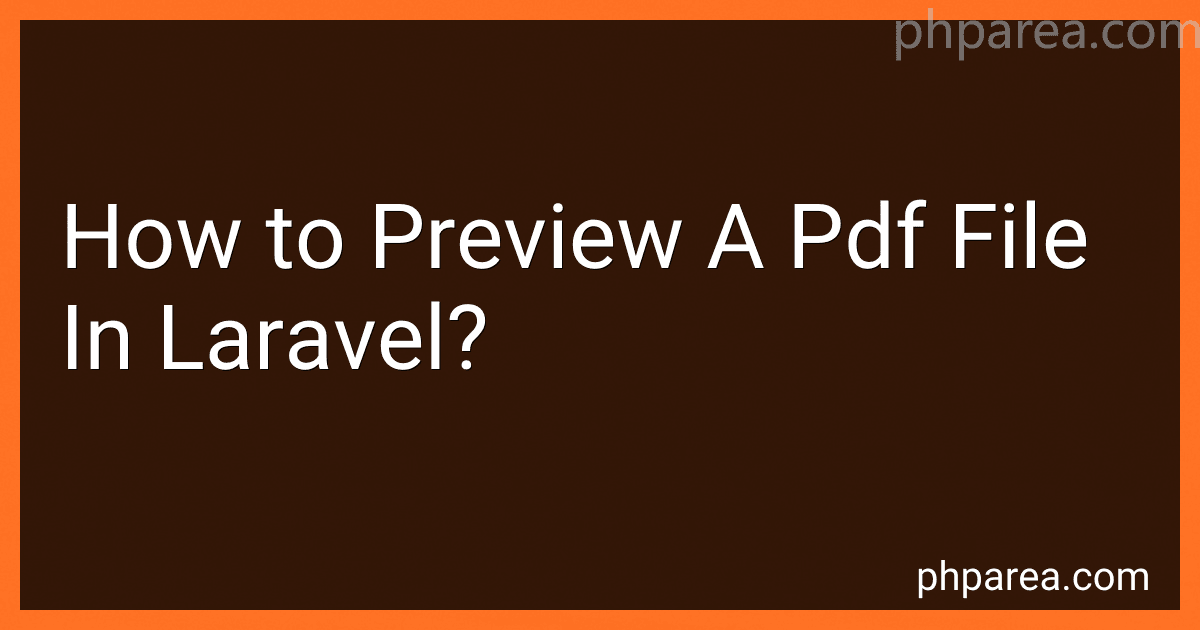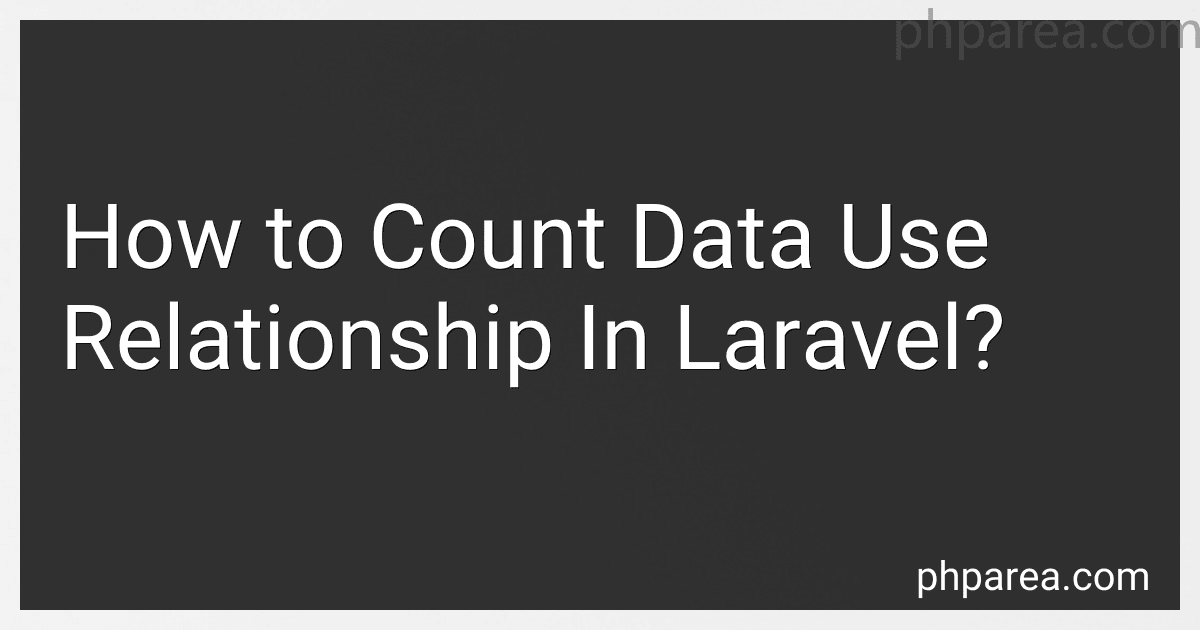Posts (page 19)
-
 8 min readTo preview a PDF file in Laravel, you can use the Embed package to embed the PDF file directly into your view.First, you'll need to install the package by running composer require vguarneri/laravel-embed.Next, you can use the embed method in your blade view to display the PDF file. For example, if you have a PDF file stored in your storage directory, you can do something like this: {{ embed(public_path('storage/pdf/myfile.
8 min readTo preview a PDF file in Laravel, you can use the Embed package to embed the PDF file directly into your view.First, you'll need to install the package by running composer require vguarneri/laravel-embed.Next, you can use the embed method in your blade view to display the PDF file. For example, if you have a PDF file stored in your storage directory, you can do something like this: {{ embed(public_path('storage/pdf/myfile.
-
 3 min readTo disable SSL verification in Guzzle in Laravel, you can set the verify option to false when making a request using the Guzzle client. This can be done by passing an array of options with the verify key set to false when calling the request() method on the client. This will ignore SSL verification and allow requests to be made without checking the server's SSL certificate.
3 min readTo disable SSL verification in Guzzle in Laravel, you can set the verify option to false when making a request using the Guzzle client. This can be done by passing an array of options with the verify key set to false when calling the request() method on the client. This will ignore SSL verification and allow requests to be made without checking the server's SSL certificate.
-
 4 min readTo add custom ini_set in Laravel, you can make use of the ini_set() function in your Laravel application. You can add custom ini settings by defining them in your bootstrap/app.php file. Simply add the ini_set() function with the desired configuration key and value before the application is created. This will ensure that your custom ini settings are applied globally throughout your Laravel application.
4 min readTo add custom ini_set in Laravel, you can make use of the ini_set() function in your Laravel application. You can add custom ini settings by defining them in your bootstrap/app.php file. Simply add the ini_set() function with the desired configuration key and value before the application is created. This will ensure that your custom ini settings are applied globally throughout your Laravel application.
-
 6 min readHandling complex relations with Laravel can be challenging, but it is certainly achievable with the right approach. One of the key aspects to consider is defining the relationships between different models correctly in your Eloquent models. Laravel provides various types of relationships like one-to-one, one-to-many, many-to-many, and polymorphic relationships that can be utilized based on the requirements of your application.
6 min readHandling complex relations with Laravel can be challenging, but it is certainly achievable with the right approach. One of the key aspects to consider is defining the relationships between different models correctly in your Eloquent models. Laravel provides various types of relationships like one-to-one, one-to-many, many-to-many, and polymorphic relationships that can be utilized based on the requirements of your application.
-
 7 min readTo count data use relationship in Laravel, you can use the withCount() method provided by Eloquent ORM. This method allows you to retrieve the count of related records for a given relationship.You simply need to include the withCount() method when querying the data and specify the relationship you want to count.
7 min readTo count data use relationship in Laravel, you can use the withCount() method provided by Eloquent ORM. This method allows you to retrieve the count of related records for a given relationship.You simply need to include the withCount() method when querying the data and specify the relationship you want to count.
-
 5 min readTo upload a canvas image in the public folder in Laravel, you can follow these steps:Create a form in your Blade view to allow users to upload an image.Handle the form submission in a controller method by storing the uploaded image in a temporary location.Convert the canvas image to a file format that can be saved, such as PNG or JPEG.Use the Storage facade or the Filesystem class to move the image from the temporary location to the public folder.
5 min readTo upload a canvas image in the public folder in Laravel, you can follow these steps:Create a form in your Blade view to allow users to upload an image.Handle the form submission in a controller method by storing the uploaded image in a temporary location.Convert the canvas image to a file format that can be saved, such as PNG or JPEG.Use the Storage facade or the Filesystem class to move the image from the temporary location to the public folder.
-
 5 min readTo fetch and update data in Laravel, you can use Eloquent ORM which allows you to interact with your database tables using PHP syntax.To fetch data, you can use methods like all() to retrieve all records from a table, find() to retrieve a single record by its primary key, or where() to query records based on certain conditions.
5 min readTo fetch and update data in Laravel, you can use Eloquent ORM which allows you to interact with your database tables using PHP syntax.To fetch data, you can use methods like all() to retrieve all records from a table, find() to retrieve a single record by its primary key, or where() to query records based on certain conditions.
-
 7 min readIn Laravel, to set two columns as a primary key in a database table, you need to define the primary key in your migration file using the primary() method on the schema builder. You can pass an array of column names to the primary() method to set multiple columns as the primary key.
7 min readIn Laravel, to set two columns as a primary key in a database table, you need to define the primary key in your migration file using the primary() method on the schema builder. You can pass an array of column names to the primary() method to set multiple columns as the primary key.
-
 7 min readIn Laravel, you can regenerate the session ID and token for an authenticated user by calling the Session::migrate() method. This method will create a new session ID and regenerate the CSRF token for the user. By regenerating the session, you can help prevent session fixation attacks and enhance the security of your application.You can use this method to regenerate the user's session at any point in your controller or middleware by calling Session::migrate().
7 min readIn Laravel, you can regenerate the session ID and token for an authenticated user by calling the Session::migrate() method. This method will create a new session ID and regenerate the CSRF token for the user. By regenerating the session, you can help prevent session fixation attacks and enhance the security of your application.You can use this method to regenerate the user's session at any point in your controller or middleware by calling Session::migrate().
-
 6 min readTo validate a pivot table in Laravel, you can use Laravel's validation rules by defining the rules in the App\Http\Requests folder. You can create a new Request class or update an existing one to include the validation rules for the pivot table. In the rules method of the Request class, you can specify the validation rules for the pivot table fields by using the array validation rule along with other validation rules such as required, integer, etc.
6 min readTo validate a pivot table in Laravel, you can use Laravel's validation rules by defining the rules in the App\Http\Requests folder. You can create a new Request class or update an existing one to include the validation rules for the pivot table. In the rules method of the Request class, you can specify the validation rules for the pivot table fields by using the array validation rule along with other validation rules such as required, integer, etc.
-
 4 min readTo add a custom validation method in Laravel, you can create a new Validator rule by extending the Validator class. You can do this by creating a new service provider or adding the custom validation method directly in the boot() method of your app service provider.In the custom validation method, you will define the logic for validating the input data based on your specific requirements.
4 min readTo add a custom validation method in Laravel, you can create a new Validator rule by extending the Validator class. You can do this by creating a new service provider or adding the custom validation method directly in the boot() method of your app service provider.In the custom validation method, you will define the logic for validating the input data based on your specific requirements.
-
 3 min readIn Laravel, you can easily display the file names before submitting a form by using JavaScript. You can create an event listener for the file input field and then retrieve the selected file names when a file is selected. This way, you can dynamically display the selected file names on the page before the form is submitted. This provides a better user experience as users can see which files they have selected before completing the form submission.
3 min readIn Laravel, you can easily display the file names before submitting a form by using JavaScript. You can create an event listener for the file input field and then retrieve the selected file names when a file is selected. This way, you can dynamically display the selected file names on the page before the form is submitted. This provides a better user experience as users can see which files they have selected before completing the form submission.